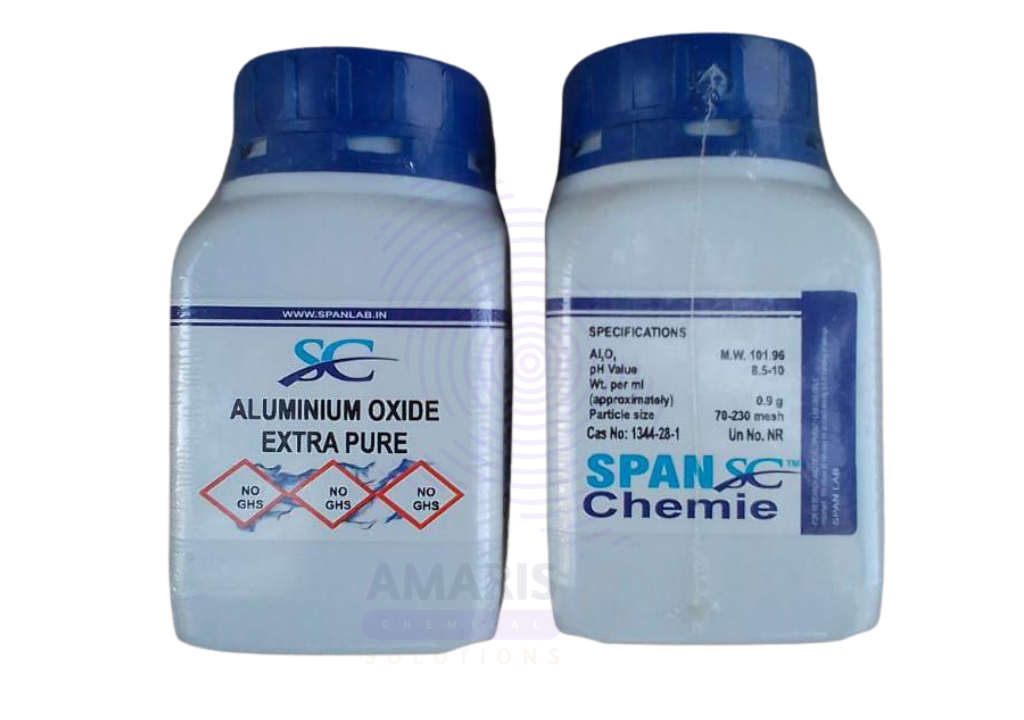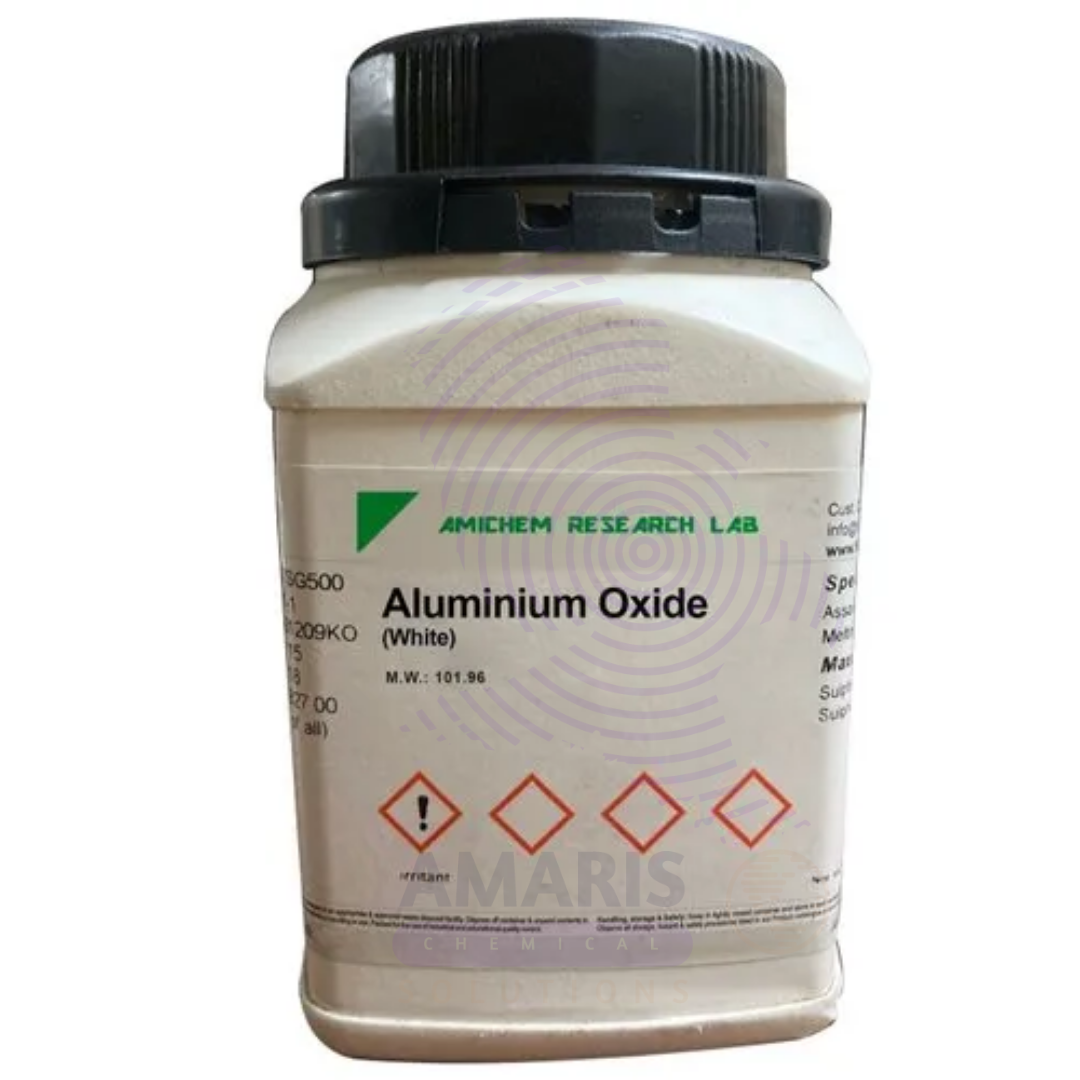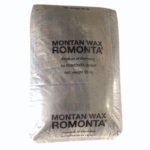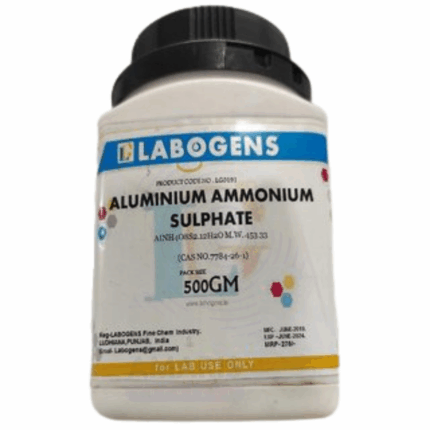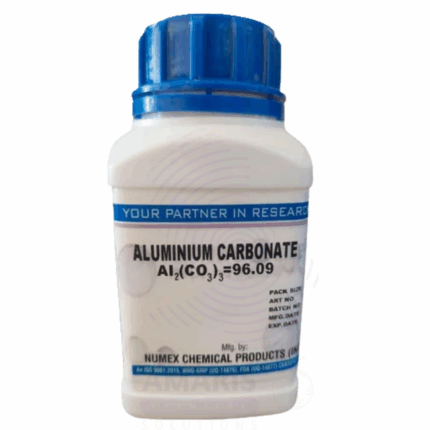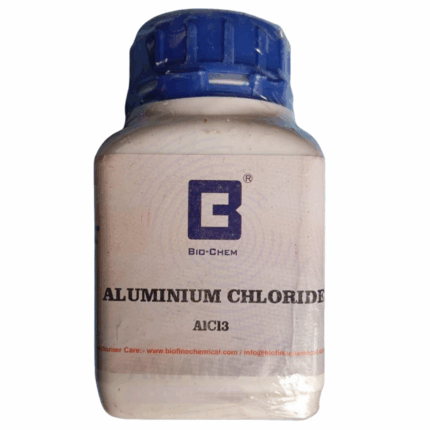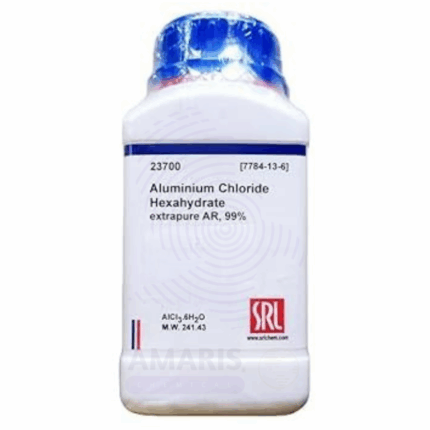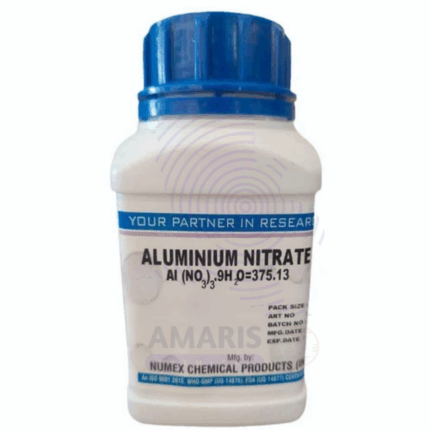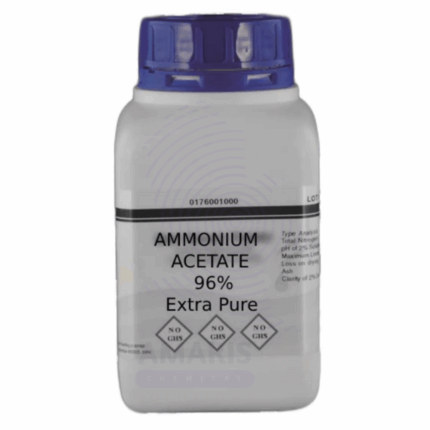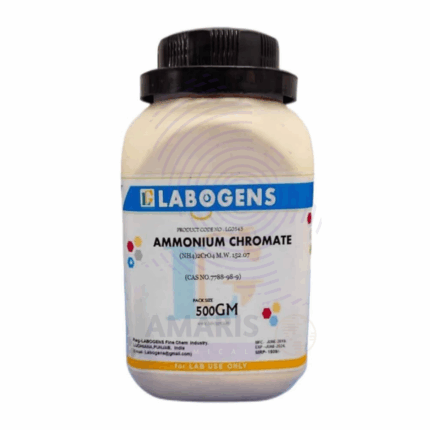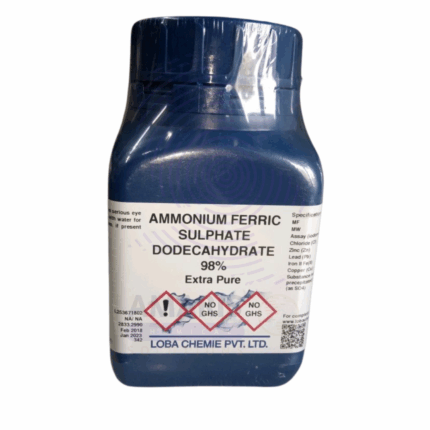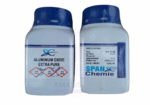
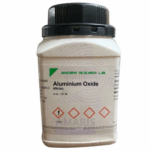
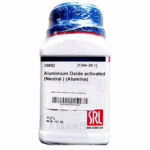
Aluminium Oxide Extra Pure
$ 23.00 Original price was: $ 23.00.$ 22.34Current price is: $ 22.34.
Aluminium Oxide Extra Pure is a high-purity, white, odorless crystalline powder widely used in laboratory applications for its chemical stability, hardness, and high melting point. It serves as a reliable reagent in inorganic synthesis, a polishing and grinding medium in sample preparation, and a support material for catalysts in chemical reactions. This form of alumina is also used in adsorption studies, ceramic research, and as a desiccant in controlled drying processes. Its extra pure grade ensures minimal contamination, making it suitable for sensitive analytical work and high-precision experiments. For optimal performance, it should be stored in a dry, tightly sealed container to prevent moisture absorption and maintain its physical integrity.
Aluminium Oxide Extra Pure
Primary Uses
- Reagent in Inorganic and Solid-State Chemistry
- Serves as a chemically inert material in high-temperature reactions and ceramic/glass synthesis.
- Crucible or Support Material
- Used to line or fill crucibles and reaction vessels in labs involving thermal processing or calcination.
- Calibration Standard for Instrumentation
- Used as a known standard in techniques like X-ray diffraction (XRD) or thermal analysis (TGA/DSC).
- Study of Refractory and Thermal Stability
- Ideal for experiments involving material stability at elevated temperatures or oxidative environments.
- Base Material in Synthesis of Advanced Materials
- Utilized in forming composites, nanomaterials, or metal oxide frameworks in research labs.
Secondary Uses
- Filler in Laboratory Formulations
- Used as an inert, high-density filler in research on resins, polymers, and high-performance coatings.
- Polishing Agent for Sample Preparation
- Employed in fine abrasive processes to polish metallographic or optical samples.
- Model Compound in Surface Science
- Investigated in studies on adsorption, catalysis, or surface modification due to its defined surface properties.
- Educational Demonstrations of Ceramic Properties
- Used to illustrate the characteristics of ceramics such as hardness, thermal resistance, and chemical inertness.
- Environmental Chemistry Studies
- Acts as a non-reactive matrix in simulations of soil absorption, contaminant diffusion, or material interaction.
| PACK SIZE |
500 grams Plastic Tin |
|---|
1. Basic Identification Attributes
- Chemical Name: Aluminium Oxide
- CAS Number: 1344-28-1
- HS Code: 28182000 (Aluminium oxide, excluding artificial corundum)
- Molecular Formula: Al₂O₃
- Synonyms:
- Alumina
- Aluminium(III) oxide
- Al₂O₃
- Corundum (natural crystalline form)
- Activated alumina (if treated for high surface area)
2. Physical & Chemical Properties
- Physical State: Solid (fine powder or granules)
- Color & Odor: White or off-white powder; odorless
- Boiling Point: ~2,977°C
- Melting Point: ~2,072°C
- Density/Specific Gravity: ~3.95–4.0 g/cm³ (varies with form)
- Solubility:
- Water: Insoluble
- Acids/Bases: Reacts with strong acids and alkalis (amphoteric)
- pH Level: ~6–7.5 (in suspension – varies by preparation)
- Vapor Pressure: Negligible
- Flash Point: Not flammable
- Autoignition Temperature: Not applicable
- Viscosity: Not applicable (solid)
3. Safety & Hazard Attributes
- Hazard Class (GHS):
- Not classified as hazardous
- May cause mechanical irritation if inhaled as dust
- NFPA Ratings:
- Health: 1
- Flammability: 0
- Reactivity: 0
- Exposure Limits:
- OSHA PEL: 15 mg/m³ (total dust), 5 mg/m³ (respirable fraction)
- ACGIH TLV: 1 mg/m³ (respirable fraction, as aluminium)
- Reactivity:
- Chemically stable
- Amphoteric – reacts with both acids and bases at high temperatures
4. Storage & Handling Attributes
- Storage Conditions:
- Store in tightly closed containers in dry, well-ventilated areas
- Incompatible Materials:
- Strong acids (e.g., hydrofluoric acid), strong bases
- Container Type:
- Glass, plastic, or HDPE containers
- Shelf Life & Expiration Date:
- Indefinite if uncontaminated and moisture-free
- Special Handling Requirements:
- Minimize dust generation
- Use gloves, goggles, and lab coat; dust mask if airborne particles may be released
5. Regulatory & Compliance Attributes
- Regulatory Status:
- Listed in TSCA, REACH, and other global inventories
- Widely used in academic, analytical, and industrial research labs
- Hazard Symbols (GHS Pictograms):
- None required
- Transportation Restrictions:
- Not regulated for transport
- Waste Disposal Method:
- Dispose of as non-hazardous solid waste
- If contaminated, treat accordingly under hazardous waste protocols
6. Environmental & Health Impact
- Ecotoxicity:
- Very low; inert and non-toxic in environmental concentrations
- Persistence in Environment:
- Stable and non-degradable (does not dissolve or react in natural conditions)
- Carcinogenicity/Mutagenicity:
- Not classified as carcinogenic or mutagenic
- Biodegradability:
- Not biodegradable (inorganic, highly stable mineral)
SAFETY PRECAUTIONS
- Personal Protective Equipment (PPE):
- Wear a lab coat, safety goggles, and chemical-resistant gloves.
- Use a dust mask or respirator when working with fine powder to prevent inhalation.
- Handling:
- Avoid creating or inhaling dust.
- Handle in a well-ventilated area or under a fume hood.
- Prevent contact with eyes and prolonged skin exposure.
- Use non-sparking, anti-static tools if handling large quantities.
- Storage:
- Store in a tightly sealed, properly labeled container in a cool, dry, and well-ventilated area.
- Protect from moisture and incompatible substances such as strong acids and bases.
- Hygiene Measures:
- Wash hands thoroughly after handling.
- Avoid touching your face, eyes, or mouth during use.
- Do not eat, drink, or smoke in the laboratory.
FIRST AID MEASURES
- Inhalation:
- Move the person to fresh air immediately.
- Rinse mouth and nose with water if dust was inhaled.
- Seek medical advice if respiratory irritation or discomfort persists.
- Skin Contact:
- Wash the affected area with soap and water.
- Remove contaminated clothing.
- Seek medical attention if irritation develops or persists.
- Eye Contact:
- Flush eyes with plenty of water for at least 15 minutes.
- Lift eyelids occasionally during rinsing.
- Seek medical attention if irritation or blurred vision continues.
- Ingestion:
- Rinse mouth with water.
- Do not induce vomiting.
- Seek medical attention if a significant amount is ingested or if symptoms develop.
FIRE FIGHTING MEASURES
- Suitable Extinguishing Media:
- Use dry chemical powder, water spray, foam, or carbon dioxide (CO₂), depending on the surrounding fire.
- Specific Hazards:
- Non-flammable and non-combustible.
- May release fine dust that can irritate the respiratory tract if dispersed in air during a fire.
- No significant decomposition products under normal fire conditions.
- Protective Equipment for Firefighters:
- Use full protective clothing and a self-contained breathing apparatus (SCBA) in case of heavy smoke or dust.
- Firefighting Instructions:
- Focus on controlling the surrounding fire.
- Avoid creating airborne dust while extinguishing.
- Cool nearby containers with water spray.


 Preservatives(food)
Preservatives(food) Flavor Enhancers
Flavor Enhancers Acidulants
Acidulants Sweeteners
Sweeteners Antioxidants
Antioxidants Colorants(food)
Colorants(food) Nutraceutical Ingredients (food)
Nutraceutical Ingredients (food) Nutrient Supplements
Nutrient Supplements Emulsifiers
Emulsifiers
 Collectors
Collectors Dust Suppressants
Dust Suppressants Explosives and Blasting Agents
Explosives and Blasting Agents Flocculants and Coagulants
Flocculants and Coagulants Frothers
Frothers Leaching Agents
Leaching Agents pH Modifiers
pH Modifiers Precious Metal Extraction Agents
Precious Metal Extraction Agents
 Antioxidants(plastic)
Antioxidants(plastic) Colorants (Pigments, Dyes)
Colorants (Pigments, Dyes) Fillers and Reinforcements
Fillers and Reinforcements Flame Retardants
Flame Retardants Monomers
Monomers Plasticizers
Plasticizers Polymerization Initiators
Polymerization Initiators Stabilizers (UV, Heat)
Stabilizers (UV, Heat)
 Antifoaming Agents
Antifoaming Agents Chelating Agents
Chelating Agents Coagulants and Flocculants
Coagulants and Flocculants Corrosion Inhibitors
Corrosion Inhibitors Disinfectants and Biocides
Disinfectants and Biocides Oxidizing Agents
Oxidizing Agents pH Adjusters
pH Adjusters Scale Inhibitors( water)
Scale Inhibitors( water)
 Antioxidants(cosmetic)
Antioxidants(cosmetic) Emollients
Emollients Fragrances and Essential Oils
Fragrances and Essential Oils Humectants
Humectants Preservatives
Preservatives Surfactants(cosmetic)
Surfactants(cosmetic) Thickeners
Thickeners UV Filters
UV Filters
 Fertilizers
Fertilizers Soil Conditioners
Soil Conditioners Plant Growth Regulators
Plant Growth Regulators Animal Feed Additives
Animal Feed Additives Biostimulants
Biostimulants Pesticides (Herbicides, Insecticides, Fungicides)
Pesticides (Herbicides, Insecticides, Fungicides)
 Active Pharmaceutical Ingredients (APIs)
Active Pharmaceutical Ingredients (APIs) Excipients
Excipients Solvents(pharmaceutical)
Solvents(pharmaceutical) Antibiotics
Antibiotics Antiseptics and Disinfectants
Antiseptics and Disinfectants Vaccine Adjuvants
Vaccine Adjuvants Nutraceutical Ingredients (pharmaceutical)
Nutraceutical Ingredients (pharmaceutical) Analgesics & Antipyretics
Analgesics & Antipyretics
 Analytical Reagents
Analytical Reagents Solvents(lab)
Solvents(lab) Chromatography Chemicals
Chromatography Chemicals Spectroscopy Reagents
Spectroscopy Reagents microbiology-and-cell-culture-reagents
microbiology-and-cell-culture-reagents Molecular Biology Reagents
Molecular Biology Reagents Biochemical Reagents
Biochemical Reagents Inorganic and Organic Standards
Inorganic and Organic Standards Laboratory Safety Chemicals
Laboratory Safety Chemicals Specialty Laboratory Chemicals(Special Laboratory Equipment)
Specialty Laboratory Chemicals(Special Laboratory Equipment)
 Demulsifiers
Demulsifiers Hydraulic Fracturing Fluids
Hydraulic Fracturing Fluids Scale Inhibitors(oil)
Scale Inhibitors(oil) Surfactants(oil)
Surfactants(oil) Drilling Fluids
Drilling Fluids
 Dyes and Pigments
Dyes and Pigments Bleaching Agents
Bleaching Agents Softening Agents
Softening Agents Finishing Agents
Finishing Agents Antistatic Agents
Antistatic Agents
 Admixtures
Admixtures Waterproofing Agents
Waterproofing Agents Sealants and Adhesives
Sealants and Adhesives Curing Compounds
Curing Compounds Concrete Repair Chemicals
Concrete Repair Chemicals Anti-Corrosion Coatings
Anti-Corrosion Coatings
 Surfactants(cleaning)
Surfactants(cleaning) Builders
Builders Enzymes
Enzymes Solvents (Cleaning)
Solvents (Cleaning) Fragrances
Fragrances
 Electronic Chemicals
Electronic Chemicals Catalysts
Catalysts Lubricants
Lubricants Photographic Chemicals
Photographic Chemicals Refrigerants
Refrigerants Automotive chemicals
Automotive chemicals Pyrotechnic Chemicals
Pyrotechnic Chemicals
 Biodegradable Surfactants
Biodegradable Surfactants Bio-based Solvents
Bio-based Solvents Renewable Polymers
Renewable Polymers Carbon Capture Chemicals
Carbon Capture Chemicals Wastewater Treatment Chemicals
Wastewater Treatment Chemicals
 Pigments
Pigments Solvents(paint)
Solvents(paint) Specialty Coatings
Specialty Coatings Binders/Resins
Binders/Resins Additives
Additives Driers
Driers Anti-Corrosion Agents
Anti-Corrosion Agents Functional Coatings
Functional Coatings Application-Specific Coatings
Application-Specific Coatings
 Fresh Herbs
Fresh Herbs Ground Spices
Ground Spices Whole Spices
Whole Spices Spice Blends
Spice Blends Dried Herbs
Dried Herbs
 Leavening Agents
Leavening Agents Dough Conditioners
Dough Conditioners Flour Treatments
Flour Treatments Fat Replacers
Fat Replacers Decoratives
Decoratives Preservatives(baking)
Preservatives(baking)
 Plasticizers & Softeners
Plasticizers & Softeners Reinforcing Agents
Reinforcing Agents Adhesion Promoters
Adhesion Promoters Vulcanizing Agents
Vulcanizing Agents Antidegradants
Antidegradants Blowing Agents
Blowing Agents Fillers & Extenders
Fillers & Extenders Accelerators & Retarders
Accelerators & Retarders